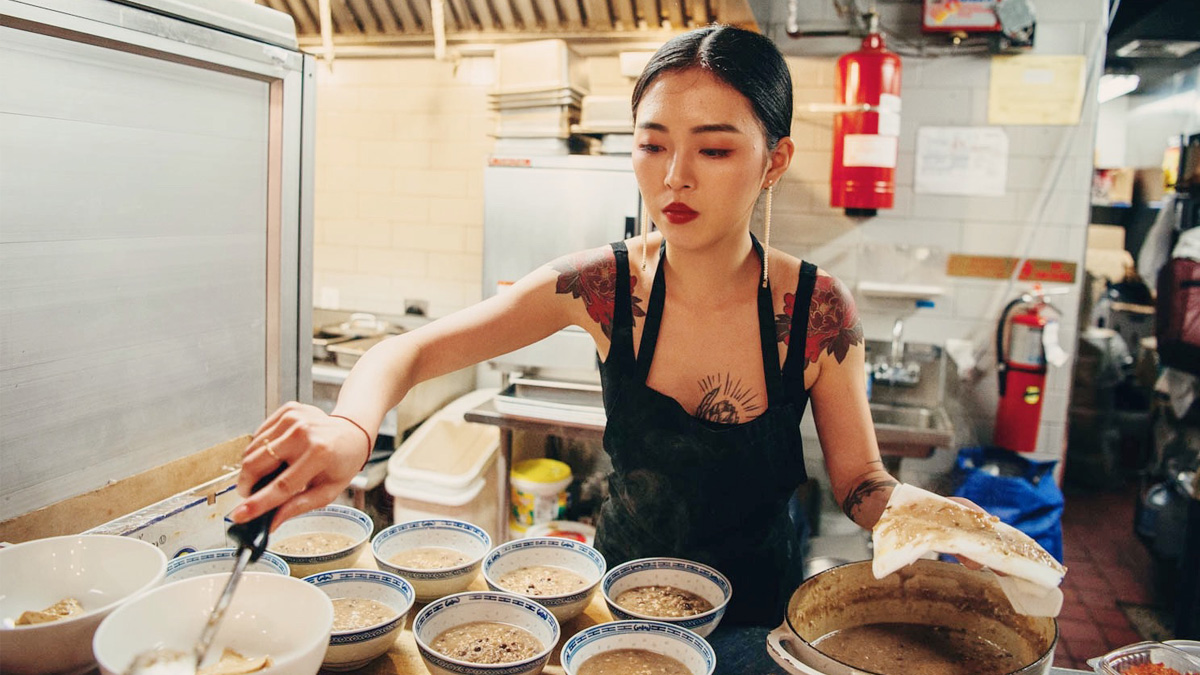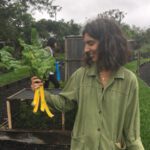Zoey Xinyi Gong is a chef and registered dietician specializing in the practice of Traditional Chinese Medicine (TCM) food therapy. In recent years, Gong has emerged as a prominent figure in the world of TCM, garnering attention on social media for her accessible approach to cooking with traditional herbs and ingredients. Her integrative, slow-food approach to wellness has resonated with many, showcasing a mindful way of eating that centers non-Western and anti-appropriation approaches to nutrition.
TCM is a system that originated in China, coming out of thousands-year-old methods of East Asian medical theory and practice. Those who aren’t familiar with the term TCM have probably heard of acupuncture, moxibustion, qi gong, gua sha, and cupping. They’ve perhaps even tried traditional food and herbs such as reishi mushroom, goji berries, gingko nuts, and jujube dates without realizing their cultural roots and medicinal properties.
While some people dismiss forms of Chinese medicine in today’s biomedically focused world, others see learning about systems like TCM as a way to uplift cultural traditions, manage chronic illness, and build an alternative understanding of their bodies. Eastern medicine practitioners such as Gong see the body’s mechanisms in terms of energy (qi), temperature (“hot” and “cold”), the five elements, yin and yang, and a system of meridians that correspond to the organs.
The author of The Five Elements Cookbook (Harper Collins, 2023), Gong showcases commonly used East Asian ingredients such as astragalus, Chinese yam, honeysuckle, Job’s tears, and angelica root in her recipes. She also emphasizes joyful eating, taking a gentle stance against one-size-fits-all diet trends.
Lion’s Roar spoke with Gong about her relationship to Buddhism, contemplative eating, the importance of beautiful food, and her journey to understanding true wellness.
How did you first come to TCM?
It was actually through my own experience of illness that I came to it. I got really sick after moving to the United States from Shanghai when I was 16. For several years, I had a lot of different things going on, including chronic joint pain, acne, skin rashes, amenorrhea, as well as breast tumors. Eventually, I realized that the only way to heal myself was to change my whole lifestyle.
Did you grow up taking Chinese medicine regularly?
It wasn’t a huge part of my life growing up. My grandma and uncle are actually biomedical doctors. That said, I think Chinese medicine is a part of every Chinese person’s life, even if we don’t notice it exactly. There are medicinal herbs used throughout our food and the medical terms are often part of our language. I grew up knowing a lot of the philosophy behind it, without really learning anything about Chinese medicine itself.
“An approach to diet can actually be very adaptable and expansive, incorporating lots of flavors, cooking methods, and joy.”
After I started to get sick, the first thing I looked into was biomedicine and Western nutrition. To be honest, I didn’t even know that it was possible to explore Chinese medicine here. Western nutrition did help me, especially with my skin problems, but it never completely solved what I would call “women’s health issues” — I still wasn’t getting my period. Luckily the tumor in my breast was benign, but it would come back every year, even after it was removed. I didn’t see long-lasting change until I tried Chinese medicine. I got my period back after just ten acupuncture sessions and one month of taking an herbal formula. After that, I really wanted to learn more.
Of course I’m not perfect — I still have times when I don’t feel the greatest, but after embracing a TCM approach to food, I feel way more connected to my body and at ease, without having to maintain a rigid, restrictive lifestyle.
Although you’re firmly rooted in a practice of Chinese food therapy that has its own particular history, you also talk about how Buddhist teachings have informed your work as a chef and author. You’ve posted an excerpt from Thich Nhat Hanh’s How to Eat on your website.
Yes, it’s the “five contemplations” of eating, one of which is, “May we recognize and transform unwholesome mental formations, especially our greed, and learn to eat with moderation.” I think many of the issues that people have with their health is not necessarily just about food. It’s about their minds. What you eat directly affects how you think and feel. Once you start to eat “bad food” — food that doesn’t fit your constitution in some way, or negatively impacts you — it can become this very sticky cycle that’s difficult to remove yourself from: the “bad food” affects your mind, and your mind affects how you choose to eat.
Interestingly, at the time I was the most sick and stressed, a friend gifted me a book called Zhāo Yīzuò Shēngmìng de Shān, by Taiwanese monk Li Hui Zhen. I don’t think there’s an English version yet. Basically, I started reading it and couldn’t stop. It introduced me to the idea that we have the freedom to choose a wise path of action. Later, this idea helped me create a sense of flexibility and relaxedness in my life, and I connected it to the philosophy of Chinese medicine. Western nutrition and Western medicine don’t have the same flavor of freedom, since so much of it is about restriction, control, and explicit instructions: follow the numbers, count your calories, take your vitamins. But after I read that book, I realized how limited this is.
An approach to diet can actually be very adaptable and expansive, incorporating lots of flavors, cooking methods, and joy. Over time, as I discovered more Buddhist teachings, my nutrition practice became more flexible; I started to have a more open-minded and holistic approach, for myself and for my patients. I started to feel less stressed and more peaceful, able to find points of calm in challenging scenarios.
Did you grow up Buddhist?
No. I had never looked into Buddhism, ever. It seemed outdated to me, growing up in China. My family was not religious. Buddhism truly seemed like something I would never, ever be into. In the US of course, there are dozens of popular books about Buddhism available in bookstores, but in China, definitely not. Now that I’m thinking about it, though, my grandma would talk about praying to the Buddha, and at major events, we would go to the local temple. I do remember one friend in elementary school who would chant the Heart Sutra, which is pretty commonly known in China, even though most people can’t recite it from memory. Concepts like doing good and selflessness are baked into the culture to some extent, but in general Buddhism wasn’t taught or talked about much.
But right after I finished Li Hui Zhen’s book, I was like, “Wow, this is good stuff.” I started to consume more Buddhist books — and of course, found my way to Thich Nhat Hanh’s How to Eat.
Nowadays, when people talk about their diet, they’re very stressed. There’s a kind of hostile relationship between person and food: What should I eat? Everything is so unhealthy. Everything makes me feel sick. But Thich Nhat Hanh’s words invite us into a warmer, more inviting contemplation of our appetites. I wanted to give people that impression too — I didn’t want to just blast them with, “Hey! Here’s some free healthy eating tips!” Additionally, the five contemplations of eating are applicable to everybody, wherever you are, whatever cultural background you come from.
Do you have a specific gratitude practice around food?
Not really, not explicitly. But I guess I always have gratitude in my mind whenever I cook — it’s sort of built into the flow of my practice. I try to honor the ingredients by minimizing food waste in the kitchen, and when I cook meat, I utilize the whole animal for the dish, making sure to use the bones to make broth. I also use the entire vegetable. I’m very consciously trying to move away from what I see in the food and beverage industry, which is, in general, incredibly wasteful.
In the same vein, a lot of your writing and work pushes back against the idea of “superfoods,” and extractive ways of approaching what are considered “ethnic” ingredients.
Yes. I can say that Chinese food therapy is not an extractive kind of philosophy. It’s about using what you have in front of you. Nowadays, a lot of popular wellness advice is very much about what: what’s in this, what’s good, what should or shouldn’t I eat.
A better, more wholesome way to approach life is to understand how your body reacts to things, and to know how you can use this knowledge to achieve a sense of balance. For me wellness is not very concrete; it’s not the things. Perhaps this is similar to conventional Buddhism wisdom: don’t focus too much on material things.
I wanted to contextualize the herbs and methods in my cookbook by weaving in Chinese history, folktales, and personal stories pertaining to the ingredients. I wanted to make them more alive, rather than just writing “reishi = immunity, adaptogenic,” etc. For people who are new to TCM, it’s also easier to remember the ingredients if they’re talked about with more vividness. I was really inspired by Yang Xiao Lu, a book of Chinese recipes from the Qing dynasty (1636-1912).
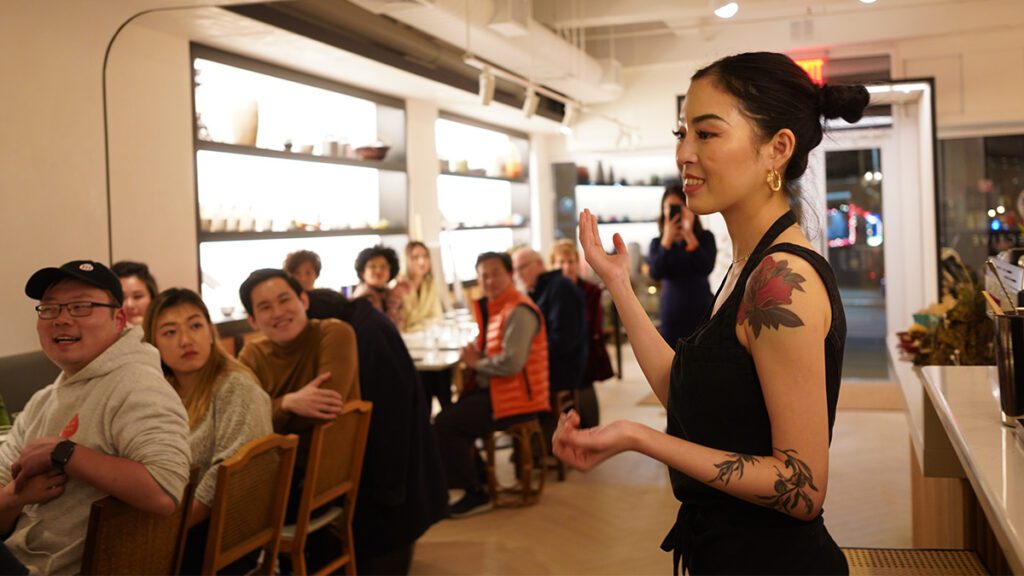
One of the first things you mention in your cookbook is joyful eating. Can you say more about that?
In the US we’re taught that “eating healthy” and joy have absolutely nothing to do with each other. It’s either/or: I either want to eat “clean,” or I want to fill my stomach with something that tastes fantastic. We think about joy in terms of immediate pleasure: the comfort food, the very sweet, very oily things that instantly satisfy us. So I talk about joyful eating in terms of happiness both in the present moment and the long run — taking the time to learn about what nutritious foods taste good to you and what you like, and how to prepare them in a mindful way.
Slowing down is essential; many people chug protein shakes or ginger shots, but how does this really make your body feel? Taking the time to make food look pleasing to the eye is important and helps calm the nervous system. We eat with all of our senses, that’s just a fact. Delicious smells, and the sounds of crunching or slurping activates our appetite. Our body guides energy toward the digestive system to process the food better. Visually, our brain loves color. It’s stimulated by a beautiful plate of food with different colors and textures. You can sense the food is well-prepared and nutritious; you feel the sense of being taken care of. On the other hand, if your food is consistently very bland, it can really impact your digestion. I saw this often when I worked as a nutritionist in a hospital. Patients were given plates of white and yellow mushes, but over time this had a harmful impact on their desire for food. In traditional Chinese dietary guidelines, one of the top criteria for food therapy is to make sure your patient’s food looks great.
It often seems like this celebration of, and aesthetic attention to food is ignored in most Western nutrition models. I’ve heard some nutrition professionals talk about an 80/20 “rule” — encouraging us to punish ourselves most of the time, in order to “indulge” 20 percent of the time.
Totally. When you talk about health over here, it’s always about “detox.” Western nutrition is rarely about nourishing or the concept of replenishing. In Chinese medicine, it’s so much about replenishing: tonifying qi, tonifying blood. Detoxifying formulas and foods are used in special circumstances, when you have a lot of excess, especially what is referred to as excess heat. Otherwise, it’s usually better to tonify. And the thing about these tonifying foods, is that they’re warm. Detoxifying foods are all very cold, and tend to take a lot out of our body.
I see my patients and friends eat a lot of salad and other cold foods, and it often gives them indigestion or bloating. What’s interesting is that they always blame themselves: “It’s my stomach, my digestion is very weak.” They never think, “Oh, it’s the salad that’s making me feel this way,” because in the West salad is considered so healthy that nobody questions that it might not be good for you. According to Chinese medicine, it’s actually quite hard for bodies to break down a huge amount of raw food in one sitting. I usually suggest switching to soups or things that are warming and easier on the stomach.
What I’m saying relates to self-reflection, which is something I learned through my encounters with Buddhism and practicing food therapy. It can be a valuable practice to do a brief meditation on what you eat every day. Oftentimes we don’t remember what we ate yesterday or this morning. It’s one way to build self-awareness and to start noticing the small moments of discomfort we feel or the changes in our body. This awareness, I think, can help prevent a lot of disease. Pain and chronic illness don’t just start like that. They usually begin with small signals that we ignore.
As a chef and dietician, you’ve talked openly about the field of nutrition and how overwhelmingly white it is, and how this can impact how non-Western foods are stigmatized or misunderstood. Do you see this changing at all?
I don’t see it changing any time soon, at least on the macro level. In science and in clinical practice, nutrition education is probably going to continue being taught in the same way. However, on a consumer level, more people are demanding culturally relevant, flexible, and holistic approaches to their health, and are paying more attention to the seasonality of ingredients and how they’re sourced.
The sad thing is, around the world, things are evolving to resemble Western-style nutrition, even in countries with rich traditions of cuisine and food therapy such as China. It’s very disappointing for me to see, but I understand why. Western nutrition is very easy to market, very easy to talk about. Doing something like TCM food therapy — there’s a huge learning curve. You have to understand the philosophy behind it to start to “get” it; it requires more time, attention, and practice. But a Western dietary model, it’s easy. You follow the rules. You don’t have to think about anything; it’s usually a list of do’s and don’ts. People tend to gravitate toward what’s easier to understand. It takes more time and space to learn about concepts like yin nourishing, cold in the spleen and stomach, dampness, and blood deficiency.
How else does Buddhism inform your life and work?
For a long time I’ve been really into Tibetan thangkas, and after moving to New York City as an adult, I started visiting the Rubin Museum and smaller galleries like Tibet House. I have a tattoo representing the three poisons (greed, hatred, and delusion) on my belly, and a Tibetan three-bladed dagger [Tibetan: phur ba; Sanskrit: kila], which symbolizes cutting through them.
My interest in Buddhism has been pretty eclectic; I actually first learned about the three poisons at a Korean temple in Manhattan during their New Year’s Eve ceremony a few years ago. I remember thinking, that makes so much sense—all our bad feelings stem from these three things. Now, whenever I feel frustrated or bad in some way, I try to categorize my feelings into the three poisons.
I’m aware there are many schools and branches of Buddhism, and at the moment I feel open to learning from all of them. From what I’ve seen, exposure to Buddhist ideas and philosophy changes people’s relationships to diet for the better, without ever having to learn something specifically about food. I think the influence is subconscious — there’s a way in which the teachings plant these seeds in your mind that might not manifest at first, but eventually, they make sense, or start to influence your lived behavior in some way.
Recipes
Try these two recipes from The Five Elements Cookbook.
Reishi Mushroom Miso Soup
Whether it’s made by a Michelin-star restaurant or your local takeout joint, miso soup is always so comforting for both our Heart and digestive system. This miso soup recipe incorporates many different kinds of mushrooms to add extra umami flavor and adaptogenic qualities. The addition of reishi, depending on the variety and form you use, may give this soup a slightly bitter aftertaste. If that bothers you, you can skip it and still make a healing bowl of miso soup.
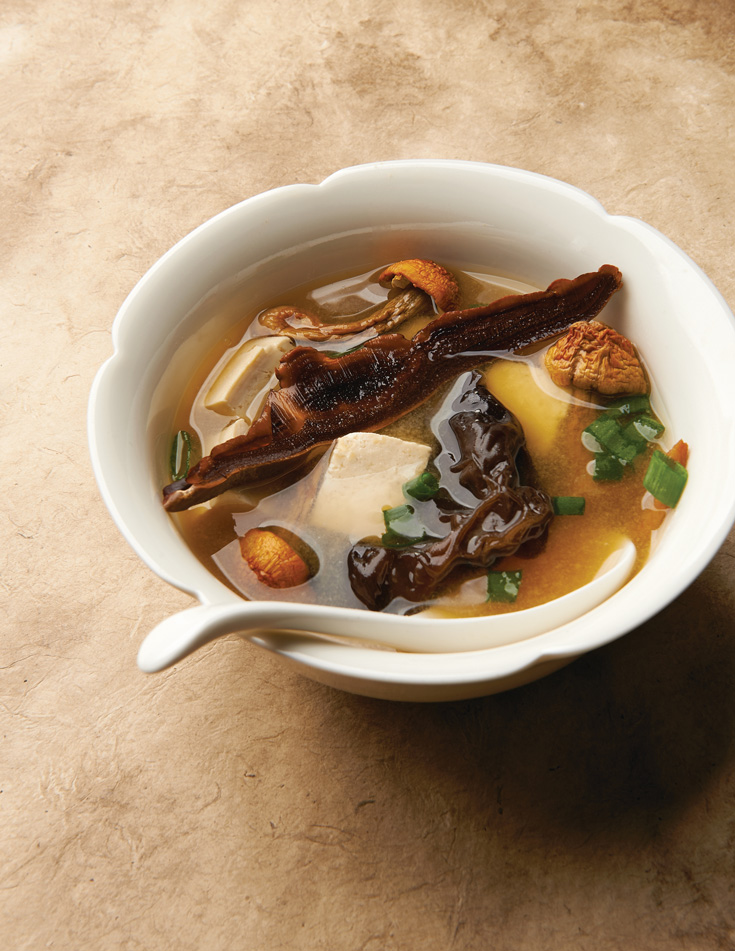
Five Elements: Water, Fire, Earth
Seasonality: Cold, Warm, Humid, Dry
Energetics: Neutral
Meridian Affinity: Heart, Stomach, Kidney
Functions: Aids Digestion, Calming
Yield: 6 servings
Time: 2 hours
10 dried or fresh black wood ear mushrooms
3 dried shiitake mushrooms 1 hand-size piece kombu
3 pieces (6 grams) reishi or 2 teaspoons reishi extract
3 teaspoons gluten-free soy sauce
2 teaspoons mirin
2 tablespoons sake
3 medium jujube dates (15 grams), pitted and halved
8 cups bone broth or vegetable stock
2 teaspoons sesame oil
1 teaspoon finely minced ginger
1/2 pound assorted fresh mushrooms, thinly sliced
3 tablespoons white or red miso paste
1/2 block (8 ounces) silken tofu, cubed
Sea salt, to taste
2 tablespoons chopped scallions, for garnish
- Carefully wash the dried wood ear mushrooms and soak in warm water for 1 hour in a medium mixing bowl. Drain. The wood ear mushrooms expand significantly after soaking. If using fresh black wood ear mushrooms, you do not need to soak them.
- In a large soup pot, add the soaked wood ear mushrooms, dried shiitake mushrooms, kombu, reishi, soy sauce, mirin, sake, jujube dates, and broth. Bring to a boil over medium heat. Reduce the heat to low and simmer, covered, for 30 minutes. Strain the base broth through a fine-mesh sieve into a large mixing bowl.
- Cut the cooked kombu into strips and set aside. Reserve the jujube dates and discard the rest of the solids.
- In the empty soup pot, heat the sesame oil over medium- high heat and cook the ginger until fragrant, about 1 minute. Add the sliced fresh mushrooms and cook for 1 minute. Pour in the prepared base broth and bring to a boil. Ladle 1/2 cup of the broth into a small bowl and add the miso paste. Stir and let the miso paste completely dissolve in the broth. Pour the miso mixture back into the soup pot. Add the cubed silken tofu and cooked kombu. Simmer for another 5 minutes. Season with sea salt.
- Ladle the soup into 6 bowls and serve warm, garnished with the chopped scallions.
Sesame Goji Granola
I had never had granola before I came to the United States, but as soon as I tried it for the first time, I definitely fell in love. It’s crunchy, sweet, nutty, and just perfect with yogurt. The addictive taste does come with the less than ideal fact that store-bought granola is often very high in sugar and fat, which can be easily adjusted if we make our own at home. This is a very simple and quick recipe for granola that has a TCM twist to it to tonify Qi and Blood and warm our body. The aroma of sesame oil pairs well with the gentle sweetness of goji berries and jujube dates. These spiced oats are crunchy, aromatic, and satisfying to have at any time of the day!
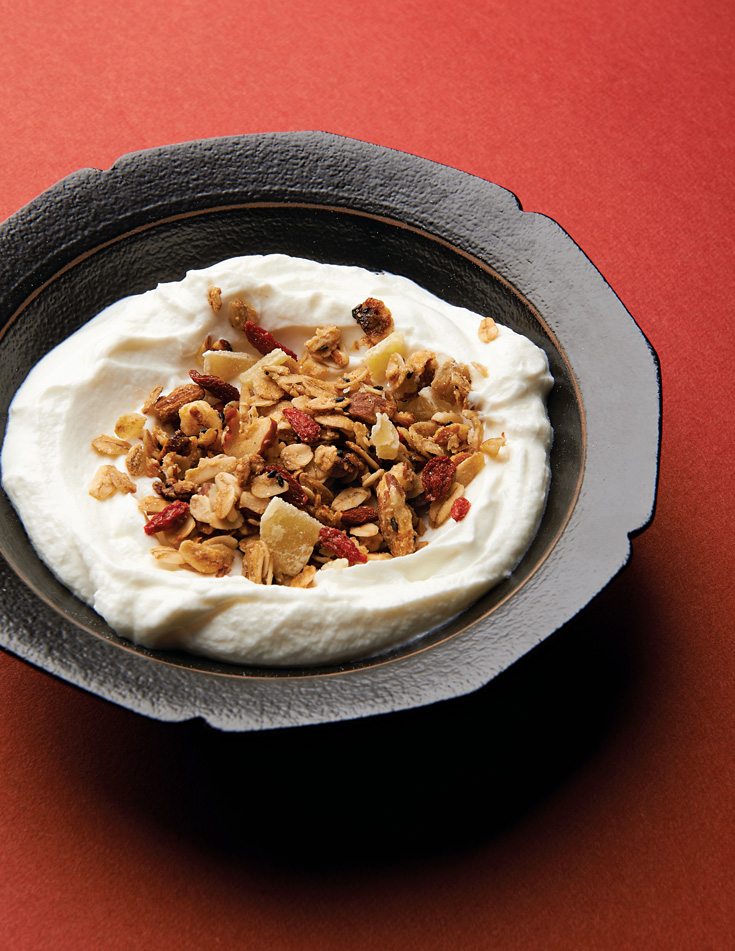
Five Elements: Metal, Wood, Water
Seasonality: Cold Energetics: Warming
Meridian Affinity: Lung, Liver, Kidney
Functions: Warming, Tonifies Qi and Blood
Yield: 2.5 cups
Time: 30 minutes
2 cups rolled oats
2 tablespoons black sesame seeds
1/2 cup chopped walnuts
2 teaspoons (5 grams) five- spice powder or ground cinnamon
3 tablespoons light brown sugar, or to taste
1 tablespoon finely minced ginger or ginger paste
1 tablespoon sesame oil
1/2 cup plant-based butter or grass-fed butter, melted
1/2 cup (25 grams) pitted and chopped jujube dates
1/4 cup (25 grams) goji berries
- Preheat the oven to 350°F.
- Place all the dry ingredients, except the jujube dates and goji berries, into a large bowl and mix. Once well combined, incorporate the ginger, sesame oil, and melted butter and toss until the dry ingredients are evenly coated, then spread the mixture in a single layer on a half baking sheet lined with parchment paper.
- Place the baking sheet in the oven and bake the granola until golden brown, about 20 minutes. Midway through baking, give the mix a stir to ensure even toasting. Three minutes before the end of baking, add the jujube dates and goji berries and continue to bake. Keep a close eye on the granola and berries in the last 3 minutes because they can easily burn at this stage.
- Remove the sheet from the oven and let the granola cool completely. Enjoy with yogurt, milk, or sweet porridge. Store at room temperature in an airtight container for up to 6 months.
